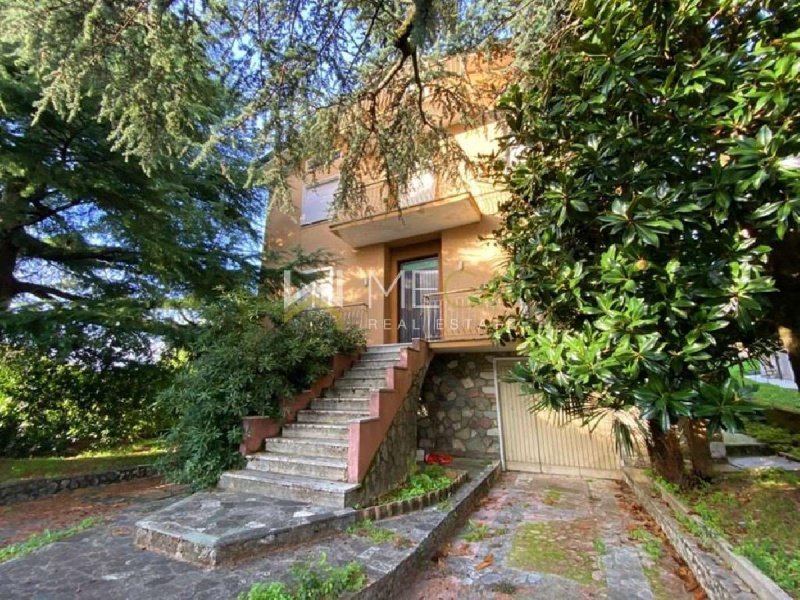Desenzano, independent villa in Desenzanino area, a short distance from the lake, the lakefront and all services.
The villa was built in the 60s and the conditions are the original ones, the lot on which the property stands measures 500 square meters, it is possible to build a swimming pool with west exposure on the back.
The villa is distributed over three floors above ground and underground:
raised ground floor with living room, kitchen, dining room, two double bedrooms, a study currently used as a single bedroom and a bathroom with window;
first floor with living room, dining room, two small rooms used as a kitchen, two bathrooms and two double bedrooms;
the second floor has a lake view, it is an attic with the possibility, already approved, of raising the roof to create a third apartment.
In the basement, which has two separate driveways, there are garages, technical rooms and accessories.
Lake Garda
Lake Garda or Benaco is the largest Italian lake, with a surface area of about 370 km² (third in depth after Como and Maggiore). A hinge between three regions, Lombardy (province of Brescia), Veneto (province of Verona), Trentino-Alto Adige (province of Trento), it is parallel to the Adige, from which it is divided by the Monte Baldo massif. To the north it is narrow and funnel-shaped while to the south it widens, surrounded by morainic hills that make the landscape softer. The lake is an important tourist destination and is visited every year by millions of people. In Roman times the lake was known as Benacus and was venerated by some as the god Benacus, personification of the lake itself, sometimes associated with the cult of the god Neptune. Today it is better known as Lake Garda, a toponym attested since the Middle Ages and of Germanic origin, deriving from that of the town of the same name on the Veronese shore of the lake, which, together with another famous lakeside town, Gardone Riviera, and other lesser-known ones, such as Gàrdola, Gardoncino, Gardoni, Guàrdola and Le Garde, testifies to the Germanic presence that goes from the 6th to the 8th century, in particular the Lombard one. The toponym Garda, with which the lake is already called in some documents of the 8th century, is the evolution of the Germanic term warda, or "guard place" or "observation place". The classic toponym of the lake, or Benācus lacus (Benaco), is almost certainly of Celtic origin.
自动翻译所用的语言
Desenzano, villa indipendente in zona Desenzanino, a brevissima distanza dal lago, lungolago e tutti i servizi.
La villa è stata costruita negli anni 60 e le condizioni sono come da origine, il lotto sul quale l'immobile è sito misura 500 metri quadrati, possibile realizzare piscina con esposizione a ovest sul retro.
La villa è distribuita su tre piani fuori terra e interrato :
piano terra rialzato con soggiorno, cucina, sala da pranzo, due camere matrimoniali, uno studio utilizzato al momento come camera singola ed un bagno con finestra;
piano primo con soggiorno, sala da pranzo, due piccole zone adibite a cucina, due bagni e due camere matrimoniali;
il piano secondo ha vista lago, si tratta di soffitta con possibilità, già approvata, di alzare il tetto ricavando un terzo appartamento.
Al piano seminterrato, che dispone di due ingressi carrai distinti, si trovano garage, locali tecnici e accessori.
Il lago di Garda
Il lago di Garda o Benaco è il maggiore lago italiano, con una superficie di circa 370 km² (terzo per profondità dopo Como e Maggiore). Cerniera fra tre regioni, Lombardia (provincia di Brescia), Veneto (provincia di Verona), Trentino-Alto Adige (provincia di Trento), è posto in parallelo all'Adige, da cui è diviso dal massiccio del monte Baldo. A settentrione si presenta stretto a imbuto mentre a meridione si allarga, circondato da colline moreniche che rendono più dolce il paesaggio. Il lago è un'importante meta turistica ed è visitato ogni anno da milioni di persone. In epoca romana il lago era conosciuto come Benacus e da alcuni era venerato come dio Benacus, personificazione stessa del lago, talvolta associata al culto del dio Nettuno. Oggi è meglio noto come lago di Garda, toponimo attestato fin dal Medioevo e di origine germanica, derivante da quello dell'omonima cittadina sulla sponda veronese del lago, la quale, insieme a un'altra località celebre del lago, Gardone Riviera, e altre meno conosciute, come Gàrdola, Gardoncino, Gardoni, Guàrdola e Le Garde, testimonia la presenza germanica che va dal VI all'VIII secolo, in particolare quella longobarda. Il toponimo Garda, con il quale è chiamato il lago già in alcuni documenti dell'VIII secolo, è l'evoluzione della voce germanica warda, ovvero “luogo di guardia” o “luogo di osservazione”. Il toponimo classico del lago, ovvero Benācus lacus (Benaco), è quasi sicuramente di origine celtica, precedente quindi al dominio romano, e dovrebbe derivare da bennacus, confrontabile con l'irlandese bennach, e significherebbe “cornuto”, ovvero dai molti promontori. La traduzione “cornuto” viene anche interpretata in riferimento alla penisola di Sirmione.
CLASSE ENERGETICA: G
Desenzano, unabhängige Villa in der Gegend von Desenzanino, nicht weit vom See, dem Seeufer und allen Dienstleistungen entfernt.
Die Villa wurde in den 1960er Jahren erbaut und die Bedingungen sind die ursprünglichen, das Grundstück, auf dem das Anwesen steht, ist 500 m2 groß, es besteht die Möglichkeit, auf der Rückseite ein Schwimmbad mit Westausrichtung zu bauen.
Die Villa erstreckt sich über drei oberirdische und unterirdische Etagen:
erhöhtes Erdgeschoss mit Wohnzimmer, Küche, Esszimmer, zwei Doppelzimmern, einem Arbeitszimmer, das derzeit als Einzelzimmer genutzt wird, und einem Badezimmer mit Fenster;
erster Stock mit Wohnzimmer, Esszimmer, zwei kleinen Küchenbereichen, zwei Badezimmern und zwei Doppelzimmern;
Die zweite Etage bietet Seeblick und ist ein Dachgeschoss mit der bereits genehmigten Möglichkeit, das Dach zu erhöhen, um eine dritte Wohnung zu schaffen.
Im Keller, der über zwei separate Zufahrten verfügt, befinden sich Garagen, Technikräume und Zubehör.
Gardasee
Der Gardasee oder Benaco ist der größte italienische See mit einer Fläche von etwa 370 km² (drittgrößter See nach Como und Maggiore). Es liegt zwischen den drei Regionen Lombardei (Provinz Brescia), Venetien (Provinz Verona) und Trentino-Südtirol (Provinz Trient) und verläuft parallel zur Etsch, von der es durch das Monte-Baldo-Massiv getrennt wird. Im Norden ist es schmal und trichterförmig, im Süden wird es breiter und ist von Moränenhügeln umgeben, die die Landschaft sanfter machen. Der See ist ein wichtiges Touristenziel und wird jedes Jahr von Millionen Menschen besucht. In der Römerzeit war der See als Benacus bekannt und wurde von einigen als Gott Benacus verehrt, der die Personifikation des Sees selbst war und manchmal mit dem Kult des Gottes Neptun in Verbindung gebracht wurde. Heute ist es besser bekannt als Gardasee, ein seit dem Mittelalter bezeugter Ortsname germanischen Ursprungs, der sich von dem gleichnamigen Ort auf der veronesischen Seite des Sees ableitet, der zusammen mit einem anderen berühmten Seebad, Gardone Riviera, liegt und andere weniger bekannte, wie Gàrdola, Gardoncino, Gardoni, Guàrdola und Le Garde, zeugen von der germanischen Präsenz vom 6. bis zum 8. Jahrhundert, insbesondere der lombardischen. Der Ortsname Garda, mit dem der See bereits in einigen Dokumenten aus dem 8. Jahrhundert bezeichnet wurde, ist eine Weiterentwicklung des germanischen Begriffs warda, was „Wachplatz“ oder „Ort der Beobachtung“ bedeutet. Der klassische Ortsname des Sees, nämlich Benācus lacus (Benaco), ist mit ziemlicher Sicherheit .

